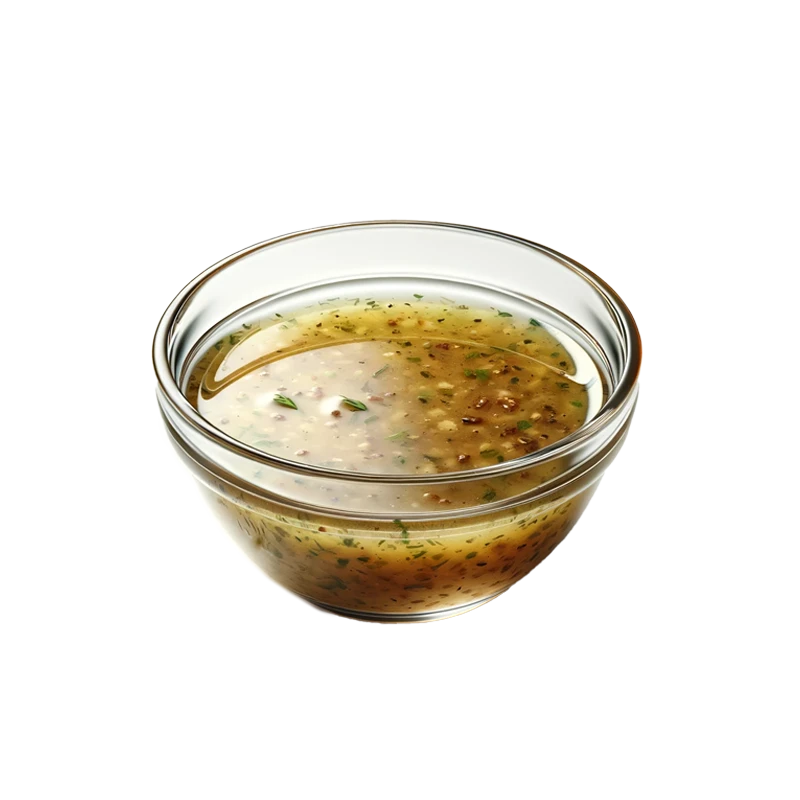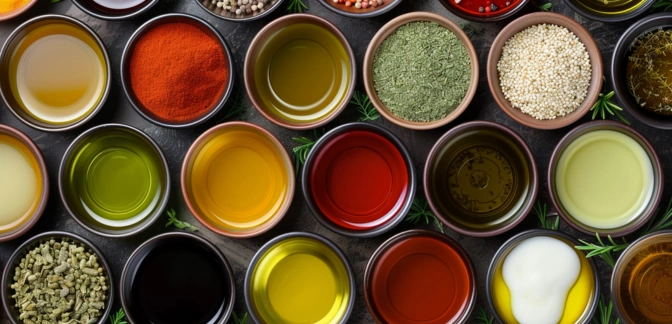Vinaigrette — Nutrients, Health Benefits, and Shopping Tips

Written by Listonic Team
Last update on September 4, 2024
Vinaigrette nutrients
Nutrition facts
Amount per 100 g
Calories
🔥 120 kcal
| Nutrition per: 100 g | Value | % Daily Value* |
|---|---|---|
| Carbs | 1 g | 0.36% |
| Fiber | 0 g | - |
| Sugars | 0 g | - |
| Glycemic Index | 0 | - |
| Protein | 0 g | - |
| Sodium | 7 mg | 0.3% |
| Total Fat | 13 g | 16.67% |
*The % of Daily Value (DV) tells you how much a nutrient in a serving of food contributes to a daily diet. 2,000 calories a day is used for general nutrition advice.
1 g
⬇️ Low Carb Content
Vinaigrette facts & tips
Health benefits
- Rich in healthy fats (when made with olive oil or other healthy oils), which support heart health by reducing bad cholesterol levels.
- Contains antioxidants from ingredients like vinegar, herbs, and spices, which help protect the body from free radicals and reduce inflammation.
- Enhances flavor in salads and vegetables, making them more enjoyable and encouraging healthy eating habits.
- Low in calories compared to creamy dressings, making it a healthy option for weight management.
Health risks
- High sodium content in many commercial vinaigrettes, which can contribute to hypertension and increased cardiovascular risks when consumed frequently.
- High fat content particularly in vinaigrettes made with large amounts of oil, which can contribute to increased calorie intake and weight gain if consumed in large quantities.
- Potential for added sugars in some commercial vinaigrettes, which can contribute to weight gain, tooth decay, and increased risk of diabetes.
- Potential for artificial additives such as preservatives, flavorings, or colorings in some commercial vinaigrettes, which may cause adverse reactions in sensitive individuals.
How to choose vinaigrette
A quality vinaigrette should have a perfect emulsion of oil and vinegar, seasoned with herbs or spices. The flavor should be tangy but balanced, with no particular ingredient overpowering the others.
Separation in the bottle is natural, but if it doesn’t re-emulsify upon shaking, or tastes overly acidic, it's best left on the shelf. Avoid vinaigrettes that contain artificial colors or flavors.

How to store vinaigrette
Vinaigrette should be stored in the refrigerator, preferably in a sealed bottle or airtight container. Refrigeration preserves its flavor and freshness for up to a month. Shake well before each use to maintain consistency.
Exposure to air can cause vinaigrette to lose its flavor. Avoid leaving it uncovered, and ensure the container is tightly closed after each use. Always check for any signs of separation or off smells before using.
✅ Extra Tip
How long does it last?
Vinaigrette can last for 1-2 months in the refrigerator once opened. Unopened, it can last for 6-12 months when stored in a cool, dark place. Always check the expiration date on the packaging for the best quality.
What to do with leftovers?
Leftover vinaigrette can be used in a variety of culinary and non-culinary ways. In the kitchen, vinaigrette is not only a salad dressing but can also be used as a marinade for chicken, pork, or vegetables, adding a sweet and tangy flavor. Vinaigrette can also be mixed into pasta or potato salads for added flavor or used as a glaze for roasted meats.
Beyond cooking, vinaigrette has some unconventional uses. Oil-based vinaigrettes can be used as a quick polish for wooden furniture, thanks to their oil content. Simply apply a small amount to a soft cloth and buff the surface to bring out the wood’s shine. Additionally, vinaigrette can be used in DIY beauty treatments; for example, oil-based vinaigrettes can be used as a deep-conditioning treatment for dry hair. Simply apply it to the hair, leave it on for a few minutes, and then rinse thoroughly. However, be cautious with any vinaigrette that contains strong acids or other ingredients that may not be suitable for skin or hair use.
👨⚕️️ Medical disclaimer
Discover products from other categories
Listonic Team
Fact-checked
Our editorial team checked this article to make sure it was accurate at the time of publishing it.
Get the top-rated shopping list app on your phone!







